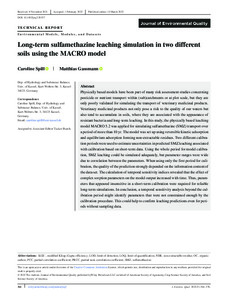Long-term sulfamethazine leaching simulation in two different soils using the MACRO model
| dc.date.accessioned | 2022-07-11T14:32:26Z | |
| dc.date.available | 2022-07-11T14:32:26Z | |
| dc.date.issued | 2022-02-16 | |
| dc.identifier | doi:10.17170/kobra-202205186202 | |
| dc.identifier.uri | http://hdl.handle.net/123456789/13991 | |
| dc.description.sponsorship | Gefördert im Rahmen des Projekts DEAL | ger |
| dc.language.iso | eng | eng |
| dc.rights | Namensnennung 4.0 International | * |
| dc.rights.uri | http://creativecommons.org/licenses/by/4.0/ | * |
| dc.subject.ddc | 500 | |
| dc.title | Long-term sulfamethazine leaching simulation in two different soils using the MACRO model | eng |
| dc.type | Aufsatz | |
| dcterms.abstract | Physically based models have been part of many risk assessment studies concerning pesticide or nutrient transport within (sub)catchments or at plot scale, but they are only poorly validated for simulating the transport of veterinary medicinal products. Veterinary medicinal products not only pose a risk to the quality of our waters but also tend to accumulate in soils, where they are associated with the appearance of resistant bacteria and long-term leaching. In this study, the physically based leaching model MACRO 5.2 was applied for simulating sulfamethazine (SMZ) transport over a period of more than 10 yr. The model was set up using reversible kinetic adsorption and equilibrium adsorption forming non-extractable residues. Two different calibration periods were used to estimate uncertainties in predicted SMZ leaching associated with calibration based on short-term data. Using the whole period for model calibration, SMZ leaching could be simulated adequately, but parameter ranges were wide due to correlation between the parameters. When using only the first period for calibration, the quality of the prediction strongly depended on the information content of the data set. The calculation of temporal sensitivity indices revealed that the effect of complex sorption parameters on the model output increased with time. Thus, parameters that appeared insensitive in a short-term calibration were required for reliable long-term simulations. In conclusion, a temporal sensitivity analysis beyond the calibration period might identify parameters that were not constrained enough by the calibration procedure. This could help to confirm leaching predictions even for periods without sampling data. | eng |
| dcterms.accessRights | open access | |
| dcterms.creator | Spill, Caroline | |
| dcterms.creator | Gaßmann, Matthias | |
| dc.relation.doi | doi:10.1002/jeq2.20337 | |
| dc.subject.swd | Pestizidrückstand | ger |
| dc.subject.swd | Nährstoff | ger |
| dc.subject.swd | Stofftransport <Biologie> | ger |
| dc.subject.swd | Tierarzneimittel | ger |
| dc.subject.swd | Sulfadimidin | ger |
| dc.subject.swd | MACRO | ger |
| dc.subject.swd | Modell | ger |
| dc.subject.swd | Adsorptionsgleichgewicht | ger |
| dc.subject.swd | Auswaschung | ger |
| dc.type.version | publishedVersion | |
| dcterms.source.identifier | eissn:1537-2537 | |
| dcterms.source.issue | Issue 3 | |
| dcterms.source.journal | Journal of Environmental Quality | eng |
| dcterms.source.pageinfo | 364-376 | |
| dcterms.source.volume | Volume 51 | |
| kup.iskup | false |
Files in this item
This item appears in the following Collection(s)
-
Artikel [1103]


